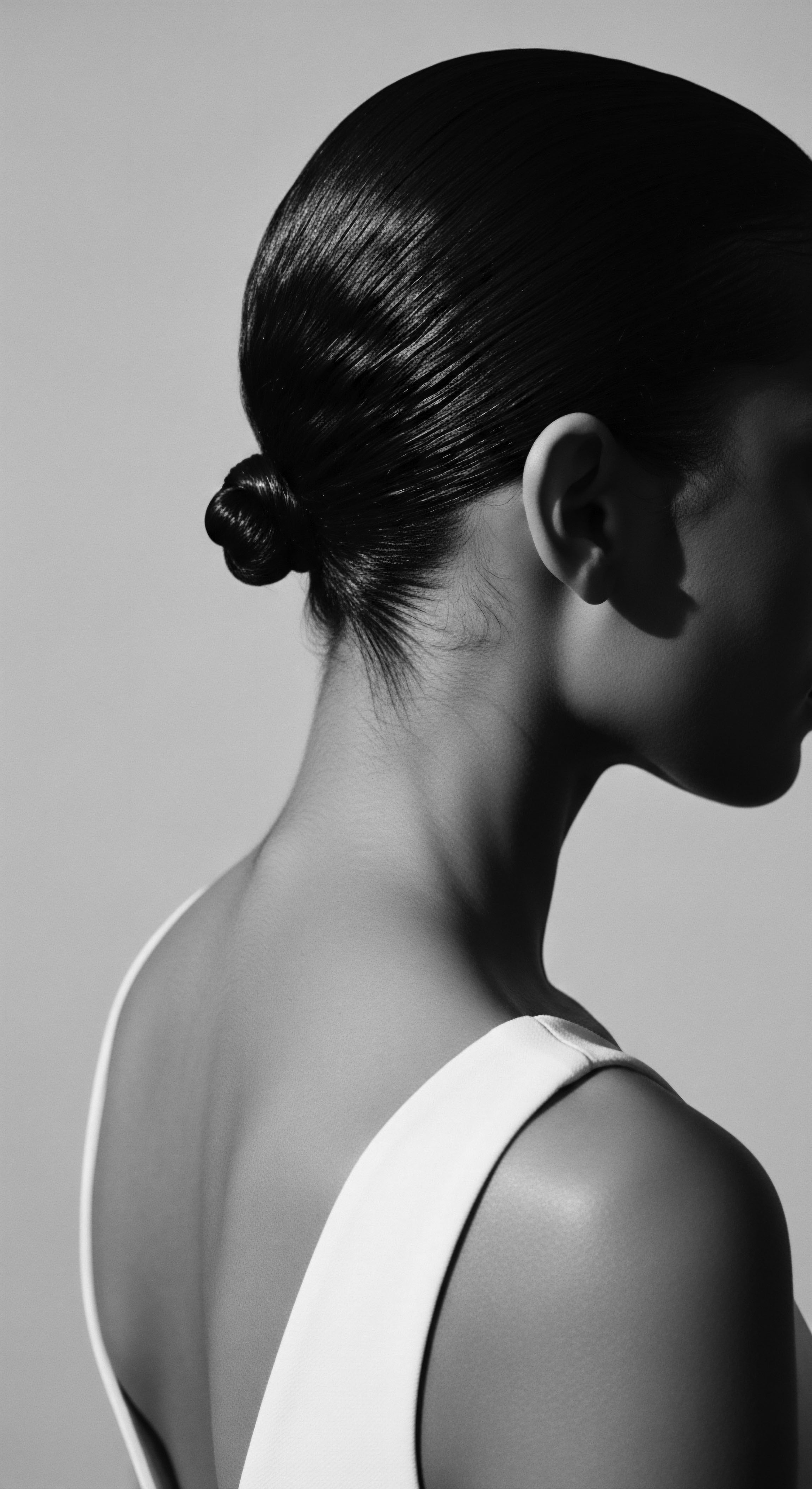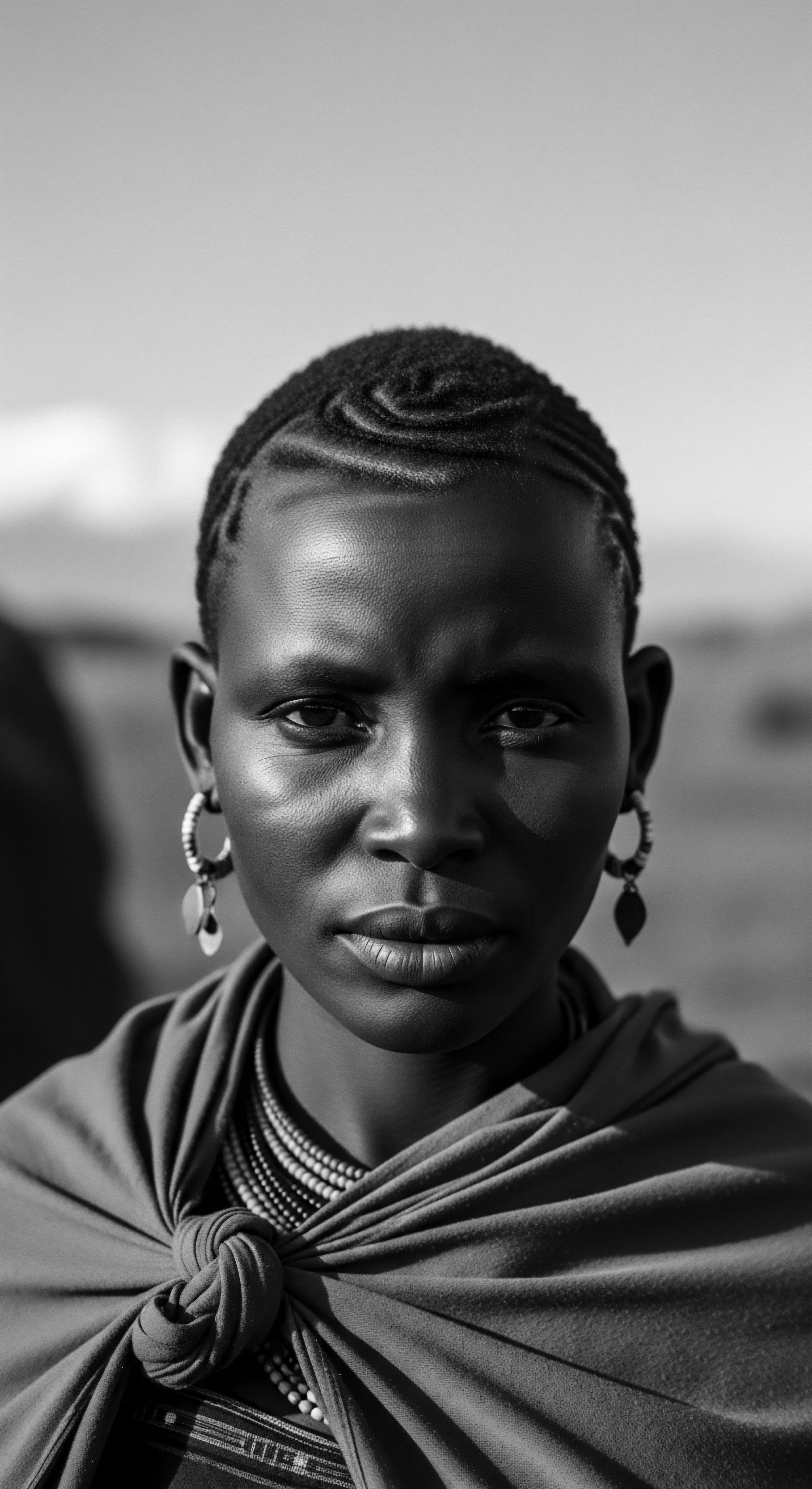
Roots
Consider the stories held within each strand, a silent archive of lineage and resilience. For those with textured hair, this connection runs particularly deep, often reaching back through generations, across continents, and into ancient practices. We speak of heritage, not as a static relic, but as a vibrant, living current that flows from the ancestral past into the present, shaping our understanding of beauty and care.
In the verdant heart of the Amazon, indigenous communities have, for millennia, listened to the land, gleaning its secrets to tend to their textured crowns. Their wisdom offers a counterpoint to modern conceptions, proposing a symbiotic relationship with nature where hair care is an extension of ecological stewardship and communal life.
This ancient knowledge offers insight into how hair thrives when honored as a biological extension of the self, deeply tied to environmental rhythms. The practices employed by these communities reflect an intimate understanding of hair’s fundamental needs, observed through generations of careful practice. This understanding arose from observing the interaction between the human body and the abundant botanical resources of their homeland, translating into practical wisdom for hair health.

Hair’s Structure and Ancient Wisdom
Textured hair, with its diverse coil, curl, and wave patterns, possesses a unique architecture. The elliptical shape of the follicle, the differing angles at which hair exits the scalp, and the variations in cuticle layers all contribute to its distinct properties, including a propensity for dryness and a particular sensitivity to external stressors. For indigenous Amazonian peoples, this inherent structure was not a scientific curiosity but a lived reality, dictating specific approaches to cleansing, conditioning, and protection. Their methods developed through empirical observation, long before the advent of microscopy.
They understood, for instance, that certain oils, like those from the Patauá palm or Babassu, were exceptionally good at coating and sealing the hair shaft, providing moisture and reducing friction. This knowledge bypassed formal anatomical study, arriving at equally effective conclusions through patient, experiential learning.
The surrounding environment played a crucial role in shaping these practices. The high humidity of the Amazon rainforest naturally influenced how hair behaved. Constant exposure to sun and insects also necessitated protective measures. These external conditions led to the development of remedies and routines that directly addressed the needs of hair in such a climate, creating a natural synergy between hair biology and ecological conditions.

Botanical Knowledge and Hair Classification
Indigenous Amazonian communities possess no universal, formal classification system for hair textures comparable to modern numerical or alphabetical charts. Instead, their understanding of hair likely resides in a practical, observational framework, categorized by how various individuals’ hair responds to specific plant treatments or environmental conditions. This pragmatic classification relies on recognizing how different hair types interact with plant extracts—how some hair might absorb Andiroba oil more readily, or how another might benefit more from a Cupuaçu mask. Their lexicon of hair is thus deeply intertwined with the names and applications of the local flora.
Indigenous Amazonian hair care exemplifies a profound dialogue between textured strands and the botanical wealth of the rainforest, rooted in ancestral wisdom.
Each community might hold terms for particular hair characteristics, often linked to sensory descriptions or the effects of specific preparations. The richness of this vocabulary lies not in abstract categorization but in its practical utility for tailoring plant-based applications. The language of care mirrors the language of the forest itself, a repository of specialized terms for countless useful species.

Hair’s Cycles and Environmental Influence
Hair growth, shedding, and renewal cycles are fundamental biological processes. Within indigenous Amazonian communities, these cycles were not viewed in isolation but within the broader context of natural rhythms—the flow of rivers, the seasonal changes in plant life, and even the lunar cycle. Nutritional factors, derived directly from the forest’s bounty, inherently supported hair health.
A diet rich in wild fruits, nuts, and protein from sustainable hunting and fishing provided essential vitamins, minerals, and fatty acids that nourished hair from within. The absence of processed foods and synthetic chemicals, a stark contrast to many contemporary diets, likely contributed to the vitality observed in ancestral hair.
Traditional wisdom understood the interconnectedness of scalp health and hair vitality. Preparations made from plants with cleansing or soothing properties, such as certain barks or leaves, would address scalp irritations, fostering an environment conducive to robust growth. This holistic approach, where the internal and external environment harmonized to support the body, extended naturally to hair care, recognizing it as an outward sign of overall wellbeing.

Ritual
The care for textured hair within Amazonian communities transcends mere grooming; it forms a rhythmic part of daily existence, a set of inherited practices passed down through tactile learning and communal observation. These actions, often rooted in specific ceremonies or daily routines, transform basic maintenance into a living art, each movement a testament to collective memory and cultural identity. The repetition of these traditional acts connects individuals to their ancestral lineage, ensuring the continuity of hair heritage.
The artistry of their hair styling and maintenance practices is deeply interwoven with the properties of the local plants. These methods, refined over countless generations, demonstrate a sophisticated understanding of how to work with, rather than against, the natural inclinations of textured hair. The styling is rarely about imposing a foreign aesthetic but rather enhancing the hair’s inherent qualities, reflecting a profound respect for its natural form.

Styles of Protection and Preservation
Protective styling, long recognized as a cornerstone of textured hair care in various Black and mixed-race ancestries, holds deep roots within Amazonian cultures. These styles, whether intricate braiding patterns or bundled coils, served practical purposes ❉ safeguarding hair from environmental aggressors like the intense tropical sun, keeping it free from tangles during daily activities, and shielding it from insects. Beyond utility, such styles carried social and symbolic weight. A child’s first braids, for instance, might mark a coming of age, or specific adornments could signify marital status or tribal affiliation.
- Babassu Oil ❉ Often used to soften hair and provide a protective barrier against humidity and environmental stressors.
- Patauá Oil ❉ Applied for its strengthening properties, reducing breakage, and lending a healthy luster to hair.
- Andiroba Oil ❉ Employed for scalp health, its anti-inflammatory qualities addressing irritations and fostering a balanced environment for growth.
The act of braiding or twisting hair becomes a communal ritual, particularly among women, offering moments for shared stories, instruction, and intergenerational bonding. These sessions pass down not just techniques but also the cultural significance of each style, its history, and its connection to the community’s identity. The inherited knowledge includes understanding which plant preparations best prepare hair for these styles, ensuring flexibility and preventing damage.

Traditional Tools for Textured Strands
The toolkit for Amazonian hair care relies on simplicity and natural materials, often sourced directly from the forest. These are tools born of necessity and refined by centuries of use. Combs might be carved from hardwoods, bones, or even porcupine quills, each designed to gently detangle and separate textured strands without causing undue stress. Smooth stones, gourds, or leaves might serve as vessels for mixing and applying plant preparations.
Such implements contrast sharply with many modern hair tools. Their construction speaks to a deep connection with the environment, where functionality meets sustainable resourcefulness. The handling of these tools is often part of the ritual itself, movements performed with a gentle precision that speaks to respect for both the hair and the materials used.
Amazonian hair traditions illustrate how daily care transforms into a living cultural narrative, reflecting shared heritage and an attuned understanding of botanical properties.

Adornment and Identity
Adornment, a universal human impulse, finds unique expression in Amazonian hair traditions. Natural dyes derived from plants like Achiote provide rich, earthy tones, used for body and hair painting, often for ceremonial purposes or to indicate specific life stages. Feathers, seeds, and woven natural fibers become extensions of the hairstyle, each carrying symbolic meaning, connecting the individual to the spiritual and natural worlds. This physical embellishment serves as a visual language, communicating identity, status, and communal belonging.
The way hair is styled and adorned directly reflects the community’s worldview. It mirrors the patterns found in nature, the cycles of life, and the ancestral stories that guide their existence. Hair becomes a canvas for expressing cultural narratives, a living testament to heritage that is proudly worn.

Relay
The practices of indigenous Amazonian communities extend beyond simple grooming; they represent a comprehensive approach to wellbeing, where hair care is intrinsically linked to bodily health, spiritual harmony, and ecological balance. This inherited wisdom, passed across generations, serves as a testament to deep observation and a profound interaction with the environment. It presents a sophisticated understanding of natural pharmacology, long predating formal scientific inquiry, making their methods a living library of inherited knowledge.
The continuity of these traditions is critical. It is through the consistent application of plant knowledge that communities sustain their health practices, adapting them subtly over time while preserving the core elements received from their forebears. The methods often address not just external hair concerns but also internal wellness, recognizing that true radiance emanates from within.

Regimens for Lasting Vitality
A personalized hair care regimen within these communities is less about a fixed schedule and more about responsiveness to the hair’s condition, environmental shifts, and individual needs. Cleansing rituals might involve saponin-rich plants like Mutamba, which provides a gentle lather that cleanses without stripping the hair’s natural oils. Conditioning often relies on the emollient properties of various seed and fruit oils. The selection of specific plants for a particular person or moment would depend on traditional knowledge of their properties—whether to add moisture, soothe a scalp, or promote strength.
For instance, the oil extracted from the Patauá palm is widely recognized for its high concentration of oleic acid, mirroring the fatty acid profile of human sebum, thus offering remarkable moisturization and protection for textured hair. This deep understanding of plant chemistry, albeit empirical, enabled them to select ingredients perfectly suited for their hair types.

The Nighttime Sanctuary for Textured Hair
Protecting textured hair during sleep is a crucial practice for minimizing tangles, preserving moisture, and preventing breakage. While the specific accessories like modern bonnets or silk scarves might differ, the concept of nighttime hair protection has ancestral parallels in many cultures, including some Amazonian ones. Traditionally, this might involve wrapping hair in natural leaves, soft fibers, or a simple plait to keep it contained and shielded from friction or environmental elements during rest.
This care extends the benefits of daytime treatments, allowing oils and conditioners to deeply penetrate the hair shaft without disturbance. It is a quiet moment of preventative care, ensuring the hair maintains its integrity and health over time.

Amazonian Plant Compounds for Hair Health
The Amazon rainforest holds an extraordinary pharmacopoeia for hair health, with many plants offering benefits now validated by modern science. The empirical application of these botanical agents speaks to centuries of observational study.
One compelling example comes from the use of Mutamba (Guazuma ulmifolia) for addressing hair loss and stimulating growth. Indigenous communities have long applied preparations from its bark to the scalp. Scientific studies have since identified Procyanidin B-2, a compound found in mutamba, as having hair growth-promoting properties. Research by Kamimura and others (Kamimura et al.
2002) illustrated that procyanidin B-2 could promote hair growth in laboratory settings. Further clinical trials, such as those by Takahashi and associates (Takahashi et al. 2001), have also explored its topical application as a hair growth agent. This alignment between ancient practice and contemporary scientific discovery underscores the validity of inherited Amazonian plant wisdom.
| Plant Name Patauá (Oenocarpus bataua) |
| Traditional Use For strong, healthy, and shiny hair; to reduce breakage. |
| Contemporary Understanding Rich in oleic acid, similar to hair's natural oils; offers deep conditioning and barrier protection. |
| Plant Name Andiroba (Carapa guianensis) |
| Traditional Use Treats scalp irritations, insect bites, and promotes hair growth. |
| Contemporary Understanding Contains limonoids and triterpenes with anti-inflammatory, antioxidant, and seboregulatory properties. |
| Plant Name Murumuru (Astrocaryum murumuru) |
| Traditional Use Provides softness and moisture, protects against dryness. |
| Contemporary Understanding High in lauric, myristic, and oleic acids, offering superior moisturization and improving hair elasticity. |
| Plant Name Copaiba (Copaifera spp.) |
| Traditional Use Scalp soothing, antiseptic qualities. |
| Contemporary Understanding Contains beta-caryophyllene, a compound with validated anti-inflammatory effects. |
| Plant Name This table highlights how indigenous botanical knowledge offers a foundational understanding of hair care that contemporary science continues to validate and expand. |
Beyond oils, the use of White Argila Clay from regions like Marajó Island is notable. This clay, rich in minerals such as magnesium, copper, zinc, and iron, has traditionally been applied to the scalp and hair for its cleansing and purifying effects. It helps remove impurities and toxins, creating a healthy foundation for hair growth and reconstruction. This practice demonstrates an early understanding of the importance of scalp detoxification for overall hair vitality.
The efficacy of Amazonian plant care is not simply anecdotal; it is a profound testament to generations of practical observation and a wisdom increasingly affirmed by modern scientific inquiry.

Addressing Hair Concerns with Ancient Cures
Addressing common textured hair concerns—such as dryness, brittleness, and scalp conditions—is deeply ingrained in Amazonian ancestral practices. Rather than a singular solution, a range of plant-based remedies would be employed, tailored to the specific manifestation of the problem. For persistent dryness, perhaps a longer application of deeply penetrating oils or a richer fruit pulp mask. For scalp irritation, a soothing decoction from specific bark or leaf extracts might be massaged in.
These traditional problem-solving approaches stand in contrast to a modern, product-driven paradigm. The focus rests on a preventative and restorative philosophy, where consistency and a respect for the hair’s natural state guide the remedy. The solutions are often multifaceted, combining topical application with dietary practices and even spiritual components, understanding that physical ailments often reflect a broader imbalance.

Holistic Influences on Hair Wellness
The health of textured hair within indigenous Amazonian communities is inextricably linked to a holistic worldview. Hair is not separate from the body; the body is not separate from the mind; and the individual is not separate from the community and the natural world. This interconnectedness means that hair health is a reflection of overall wellbeing—physical, mental, and spiritual.
The ancestral wellness philosophies often emphasize balance. This extends to consuming foods that provide necessary nutrients for hair, maintaining a peaceful mental state, participating in communal ceremonies, and living in harmony with the environment. The plants used for hair care are often also part of their medicinal or dietary traditions, reinforcing this seamless integration of health aspects.
A vibrant head of hair, in this context, becomes a symbol of a well-lived life, a deep connection to ancestral practices, and a respectful relationship with the land that sustains them. This perspective reminds us that true hair care extends far beyond bottles and jars, reaching into the very core of our being and our inherited place within the grand story of existence.

Reflection
In considering the ways indigenous Amazonian communities tend to textured hair with local plants, we find ourselves tracing pathways of wisdom that extend back through time. It is a story not of simple remedies, but of a profound, enduring relationship with the natural world, a kinship where human and plant work in concert to honor and sustain life. This legacy, particularly for those whose lineage connects them to the rich diversity of textured hair, speaks to the inherent ingenuity and deep knowledge of our forebears. Each oil, each leaf, each ceremony, carries the weight of generations, a testament to resilience and an unbroken chain of inherited practices.
The lessons from the Amazon encourage us to look beyond superficial solutions, inviting a more meaningful engagement with our hair—an engagement steeped in reverence for its structure, its history, and its potential. They call us to consider how our own journeys with textured hair might be enriched by adopting principles of observation, patience, and a reliance on the earth’s benevolence. This deep heritage, so powerfully expressed in the Amazonian context, offers a guiding light for future explorations of care, reminding us that the secrets to true vitality often lie in the wisdom passed down, strand by precious strand.

References
- Kamimura, A. et al. “Procyanidin B-2, extracted from apples, promotes hair growth ❉ A laboratory study.” British Journal of Dermatology, vol. 146, no. 1, 2002, pp. 41-51.
- Takahashi, T. et al. “The first clinical trial of topical application of procyanidin B-2 to investigate its potential as a hair growing agent.” Phytotherapy Research, vol. 15, no. 4, 2001, pp. 331–36.
- Sarno, R. D. & Sarno, N. (2019). The Science of Black Hair ❉ A Comprehensive Guide to Textured Hair Care. S.D.B. Publishing.
- Coiffman, R. L. (2007). The Biology and Chemistry of Hair Growth. Taylor & Francis.
- Balick, M. J. & Cox, P. A. (1996). Plants, People, and Culture ❉ The Science of Ethnobotany. Scientific American Library.
- Elisabetsky, E. & Siqueira, A. (2009). Ethnopharmacology of Sacred Plants in the Amazon. Nova Science Publishers.
- Schultes, R. E. & Raffauf, R. F. (1992). Vine of the Soul ❉ Medicine Men, Their Plants and Rituals in the Amazonian Rainforest. Synergetic Press.
- Lemos, G. M. & Almeida, M. B. (2018). Amazonian Oils and Their Cosmetic Properties. IntechOpen.
